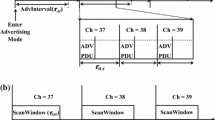Abstract
Device discovery and connection establishment are fundamental to communication between two Bluetooth (BT) devices. In this paper, we give an analytical model of the time it takes for the master in a piconet to discover one slave. We show that, even in the absence of packet interference, the discovery time can be long in some instances. We have simulated the discovery protocol by actually implementing it to validate the analytical model. By means of simulations, we show how discovery time is affected by (i) the presence of multiple potential slaves, and (ii) changes in the maximum backoff limit. Using simulation studies we observed the effectiveness of two proposed improvements to device discovery, namely, (i) avoiding repetitions of the A and B trains before a train switch, and (ii) eliminating the idea of random backoff, or reducing the backoff limit. We show that discovery time can be reduced by avoiding repetitions of the A and B trains before a train switch. However, complete elimination of the random backoff is not a good idea, as discovery time will be too long when the number of BT devices is large. Instead, choosing a small backoff limit of 250–300 slots is highly effective in reducing discovery time even in the presence of a large number (say, 50) of potential slaves.
















Similar content being viewed by others
References
Busboom, A., Herwono, I., Schuba, M., & Zavagli, G. (2002). Unambiguous device identification and fast connection setup in Bluetooth. In Proceedings of European Wireless 2002, Florence, Italy.
Chakraborty, G., Naik, K., Chakraborty, D., Shiratori, N., & Wei, D. (2004). Delay analysis and improvement of the device discovery protocol in Bluetooth. In IEEE Vehicular Technology Conference, Fall 2004, Los Angeles, USA.
Conti, A., Dardari, D., Pasolini, G., & Andrisano, O. (2003). Bluetooth and ieee 802.11b coexistence: Analytical performance evaluation in fading channels. IEEE Journal on Selected Areas in Communications, 21(2), 259–269.
Haartsen, J. (1998). The universal radio interface for ad hoc, wireless connectivity. Ericsson Review, 3, 110–117.
Jiang, J.-R., Lin, B.-R., & Tseng, Y.-C. (2004). Analysis of Bluetooth device discovery and some speedup mechanisms. Journal of the Institute of Electrical Engineering, 11(4), 301–310.
Kim, C., Ma, J., & Lee, J. (2001). A random inquiry procedure using Bluetooth. In Proceedings of International Conference on Communications and Computing, Las Vegas.
Liu, Y., Lee, M. J., & Saadawi, T. N. (2003). A Bluetooth scatternet-route structure for multihop ad hoc networks. IEEE Journal on Selected Areas in Communications, 21(2), 229–239.
Misic, J., & Misic, V. B. (2003). Bridges of Bluetooth county: Topologies, scheduling and performance. IEEE Journal on Selected Areas in Communications, 21(2), 240–258.
Murphy, P., Welsh, E., & Frantz, J. P. (2002). Using Bluetooth for short-term ad hoc connections between moving vehicles: A feasibility study. In Proceedings of IEEE Vehicular Technology Conference, Spring 2002, pp. 414–418.
Salonidis, T., Bhagwat, P., & Tassiulas, L. (2000). Proximity awareness and fast connection establishment in Bluetooth. In Proc. of Mobile and Ad Hoc Networking and Computing (MobiHoc), Boston, pp. 141–146.
Siegemund, F., & Rohs, M. (2002). Rendezvous layer protocols for Bluetooth-enabled smart devices. In Proceedings of International Conference on Architectures of Computing Systems, Karlsruhe, Germany, pp. 256–273.
The Bluetooth Special Interest Group. Baseband specification version 1.1.http://www.bluetooth.com, 2001.
Welsh, E., Murphy, P., & Frantz, J. P. (2002). Improving connection times for Bluetooth devices in mobile environment. In Proceedings of International Conference on Fundamentals of Electronics, Communications, and Computer Science.
Woodings, R., & Joos, D., Clifton, T., & Knutson, C. D. (2002). Rendezvous layer protocols for Bluetooth-enabled smart devices. In Proceedings of 3rd Annual Wireless Communication and Networking Conference (WCNC), pp. 342–349.
Zaruba, G.V., & Gupta, V. (2004). Simplified Bluetooth device discovery—analysis and simulation. In Proceedings of the 37th Hawaii International Conference on System Sciences, 2004.
Acknowledgements
This work was partially supported by the Ministry of Education, Culture, Sports, Science and Technology, Grants-in-Aid for Scientific Research, 20500071 and 19200005 and Ministry of Internal Affairs and Communications in Japan, SCOPE project(071502003).
Author information
Authors and Affiliations
Corresponding author
Additional information
A preliminary version of this paper was presented at the IEEE Vehicular Technology Conference, Fall 2004 [2].
Rights and permissions
About this article
Cite this article
Chakraborty, G., Naik, K., Chakraborty, D. et al. Analysis of the Bluetooth device discovery protocol. Wireless Netw 16, 421–436 (2010). https://doi.org/10.1007/s11276-008-0142-1
Published:
Issue Date:
DOI: https://doi.org/10.1007/s11276-008-0142-1




